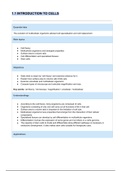Interview
IB Biology - Topic 1 (Cell Biology) Full Notes
- Course
- Institution
- Book
I was predicted 7 and achieved a high 6 in HL Biology. I spend a lot of time making my notes as detailed and coherent as possible, so they can be used as study guides to help you ace the challenging course. Thanks for checking this out!
[Show more]



